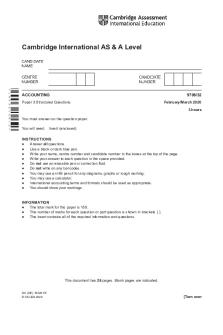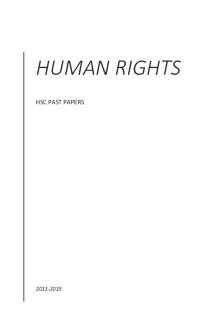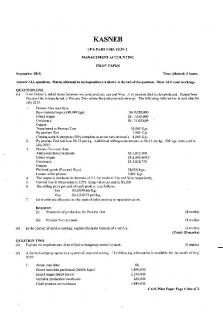Es2c50 sol - Solutions to Year2 past papers from the 2019 series PDF

| Title | Es2c50 sol - Solutions to Year2 past papers from the 2019 series |
|---|---|
| Author | Vick vi |
| Course | Dynamics and Fluid mechanics |
| Institution | The University of Warwick |
| Pages | 8 |
| File Size | 541.5 KB |
| File Type | |
| Total Downloads | 264 |
| Total Views | 376 |
Summary
UNIVERSITY OF WarwickSchool of EngineeringYear 2June 2019ES2C5 Title of Examination: -DYNAMICS AND FLUID MECHANICSPage 1Question 1MarkAllocation***************************************** Begin 1 *******************************************(a) Given: = 2 ms , = 0 m, = 5 N, = 1 m, = 1 × 10, = 1 × 10,= 9...
Description
Year 2 June 2019
UNIVERSITY OF Warwick School of Engineering ES2C5
Title of Examination: DYNAMICS AND FLUID MECHANICS
Page 1
Question 1
Mark Allocation
***************************************** Begin 1 ******************************************* (a) Given: = 2 ms , = 0.08 m, = 5 N, = 1.5 m, = 1.3 × 10
= 999 kgm , density air, = 1.23 kgm
, = 1.46 × 10
,
Marks *** B1 ***
(i) For dynamic similarity the Reynolds numbers for the sphere in water and the balloon must be the same. Reynolds number sphere in water: = Therefore, for balloon =
=
= 123,077
. .×
= 123,077 ≈ 1.2 × 10
= 123,077
→
=
.× .
123,077 = 1.198
≈ 1.2
3 marks
(ii) For equal Reynolds number / Dynamic similarity the drag coefficients for sphere and balloon will be the same. Find drag coefficient for sphere = 0.498 = = = = .
( )
(
.
)
.
Thus, = = 0.498 and with this value it follows for balloon that
= = 0.498
1.23 kgm (1.2 ms )
(b) Given: = 0.18 m, = 0.13 m, = 0.5 m s , = 12 ms
.
= 0.779 N
.
Calculate volumetric flow rate going out at section (2) = = 12 ms = 0.305 m s Mass conservation requires: = + → = − = 0.5 m s − 0.305 m s = 0.195 m s Since < it follows the flow velocity at section (3) must be directed outwards. (Note: We could have formally assigned minus sign to ‘In’ velocities and plus sign to ‘Out’ velocities to arrive at this result but it is unlikely that any student will do this. Now find average velocity at section (3): =
=
. .
=
. .
= 14.7 ms
3 marks
1 marks 2 marks 1 mark 2 marks
(c) Assume linear velocity profile between cylinder an pipe wall and apply Newton’s law of viscosity. The resulting shear stress on the surface of the cylinder will be in equilibrium with the force of gravity on the cylinder at the condition of terminal speed. From data in figure from question we conclude that the gap with between cylinder and pipe is equal to: 1 h 74 mm 73.8 mm 0.1 mm 2 V Shear stress from Newton’s law of viscosity: T h For shear force, F s , resisting downward motion need to multiply by surface area of cylinder
F s D L
VT h
Fg m g
Downward gravitational force F g is: When terminal velocity is reached we have:
Fs Fg
m g D L
VT h
6 marks
mg h VT D L
2.5 kg 9.81 7 10
-3
Ns m
0.0024525
2
m s2
0.0001 m
0.074 m 0.15 m
kg m2
s 2 10.05 m 0.000244101 N s s (Note: The downward moving cylinder acted on only by viscous friction from the oil film and by gravity never reaches so-called terminal velocity unless we allow, theoretically, an infinite span of time.)
(d) Given densities: W 998 kg m 3; steel, S 8,000kg m 3 ; mercury, M 13,550kg m 3 For the block to float the weight of the liquid it displaces must equal its own weight. Weight block: W B l d a b S g Weight displaced liquid: W L l d a W g l d b M g Equating both:
l d a b S g l d a W g l d b M g a b S a W b M a S b s a W b M
2 marks
1 mark 1 mark 2 marks
a S a W b M b s a S W b M s a b
M S
s 13,550 8,000 5550 0.79 W 8,000 998 7002
****************************************** End 1 *******************************************
1 mark
*** E1 ***
***************************************** Begin 2 ****************************************** (a) The fundamental dimensions are: Mass M , Length L , Time T . The dimensions of the quantities involved in the problem are: M M L Velocity , Density 3 , Surface Tension (= Force/Length) 2 . T L T (1) The problem formulation states We l F (V , , )
We l V
Now assume
L Introducing dimensions in (2) yields We L 1 T From this one gets
M M 3 2 L T
M 0 L0T 0 L LT M L3 M T 2 1
1 3
combining corresponding terms M L T M L Comparing the corresponding exponents yields from M : 0 (I), from L : 0 1 3 (II), (III). from T : 0 2 0
Resolving (I) for this in (II) yields
(2)
0
0
T
*** B2 ***
1 mark
2 marks
1 mark
1 mark
2
2 marks
, introducing this in (II) and then resolving (III) for
and also introducing
01 2 3 1 such that 1 . With (I) and (III) one then finds 1 and 2 . lV 2
With (2) the final solution is thus
We
1 mark
3 3 (b) Given: density mercury, M 13,550 kg m ; density water, W 998 kg m , D1 7.5 cm , D2 2.5 cm , h1 60 cm , h2 3 m
Establish ejection velocity by continuity:
V1 A1 V2 A2
V2 V1
A1 A2
V1
D 1 2
2
D 2 2
2
V1
D12 D22
m 0.075 m
2
0 .5
s
0.025 m
2
4 .5
m
Now apply Bernoulli between station (1) and (2) to establish pressure at station (2) p 1 w V12 W gz1 p 2 W V 22 W gz 2 2 2 where we use height at station (1) as datum such that z 1 0 and z 2 3 m and p 2 0 . With Eq. (A) we have kg kg 998 3 998 3 2 2 m m 0.5 m 4.5 m 998 kg 9.81 m 3 m p1 0 0 2 2 s s s2 m3
kg kg 998 3 2 2 3 m m m kg m m 0 . 5 3 m 4 . 5 9 . 81 998 p1 2 2 s s s2 m3 p1 10,105 Pa 29,371 Pa 125 Pa 39,351 Pa This result for p 1 is gauge pressure. Now, the manometer reads gauge pressure. M gh p1 W gh1 Hence, 998
p1 p1 gh W 1 W h1 M g M g M g M kg 998 3 p1 39,351 Pa W gh1 m h 0.6 m 0.3 m 0.04 m 0.34 m kg m kg M g Mg 13,550 3 9.81 2 13,550 3 m s m h
2 marks
s
(A)
3 marks
1 mark
2 marks
1 mark
(c) Neglect gravity and assume that for a free jet the pressure is constant everywhere. Control volume is indicated in figure in question. Use R for force exerted by the fluid on the vane and F R for force by vane on fluid. Component forces Fx and F y in the x and y are
F x m1 v out v in x
Fy m 2 v out v in y
and similarly
Since nozzle and vane are fixed relative to each other, m1 m2 m In
Fx 0.8
kg m m kg m m kg m kg m o 17,5 14 2 14 N 25 cos 60 30 0.8 12.5 30 0.8 s s s s s s s s s v in 0
In y direction:
Fy 0.8
and v out v 2 cos
v in v1
x direction:
and
v out v 2 sin
m kg m m kg 25 sin 60 o 0 0.8 25 0.866 s s s s s kg m m kg 17.32 2 17.32 N 21.65 s s s R x 14 N and R y 17.32 N 0.8
Hence,
7 marks
Combining R x and R y :gives resultant force R
R x 2 R y 2
This resultant force will be inclined to the
tan 1
Rx Ry
14 N 2 17.32 N 2
495.98 N 2 22.27 N
x direction at an angle
tan 1
17.32 tan 1 1.237 51.05o 14
****************************************** End 2 *******************************************
1 mark
*** E2 ***
UNIVERSITY OF Warwick School of Engineering ES2C5
Title of Examination: DYNAMICS AND FLUID MECHANICS
Question 3
***************************************** Begin 3 ******************************************* (a)
Year 2 Jan 2019 1 Mark Allocation Marks *** B3 ***
i)
Potential Energy: V = mgh Kinetic Energy: KE = ½mv2
2 marks
Potential energy of mass when y=0.4 is then: 1 mark
To find KE at y=0.4, use principle of work and energy: P.E. + K.E. = const. Potential energy at y=0 Kinetic energy at y=0
Principle of work and energy: Therefore:
2 marks
ii) Maximum height occurs (ymax) when KE=0. Principle of work and energy: reduces to: Therefore and
3 marks
iii)
W ork done by force, F, tangential to direction of motion:
In this question, F=-2 N, and so U=-2s When y=0.4, s =0.8 m Therefore 2 marks
UNIVERSITY OF Warwick School of Engineering ES2C5
Title of Examination: DYNAMICS AND FLUID MECHANICS
Question 3
Year 2 Jan 2019 Page 2 Mark Allocation Marks
iv)
When non-conservative forces act, the pri nciple of work and energy is: Where U is work done by non-conservative forces (negative in the case of friction) And so: Rearranging gives: 4 marks (b) i)
Firstly find the instantaneous centre:
4 marks
ii) The angular velocity of the bar is given by:
3 marks
1.45 rad/s iii)
The velocity magnitude at B is: 2 marks
m/s iv) the magnitude of centrpetal acceleration at A:
aA / IC ,r = -w 2 r = (1.45 2 ) ´ 0.173 = 0.364 m/s 2
***************************************** End 3 *******************************************
2 marks
*** E3 ***
UNIVERSITY OF Warwick School of Engineering ES2C5
Title of Examination: DYNAMICS AND FLUID MECHANICS
Question 4
Year 2 Jan 2019 Page 3 Mark Allocation
***************************************** Begin 4 *******************************************
Marks *** B4 ***
i) Kinetic energy of the system as a whole:
K.E.= + + = 2.55
5 marks
ii) Potential energy of the system as a whole (note, extension of the upper spring = 2 x)
2 marks
P.E.= −( + ) + (2 ) + = −49.1 + 125
4 marks
iii) Principle of work and energy: P.E. + K.E. = const
Therefore, 2.55 − 49.1 + 125 =
1 mark
Differentiate with respect to time: 2.55 2
− 49.1 + 125 2 = 0
Since v=dx/dt, we can write 5.1
=0 − 49.1 + 250
Dividing through gives: 5.1
+ 250 = 49.1
The characteristic equation (i.e. redefining x to be displacement away from equilibrium) is:
5.1 + 250 = 0
4 marks
and assuming vibration of the form = we get:
= . = 7 rad/s
3
3 marks
UNIVERSITY OF Warwick School of Engineering ES2C5
Title of Examination: DYNAMICS AND FLUID MECHANICS
Question 4 contd Marks
1 marks
2 marks
3 marks
***************************************** End 4 *******************************************
*** E4 ***...
Similar Free PDFs

2019 exam - Past exam from 2019
- 17 Pages

9706 past papers
- 28 Pages

Past exams papers 2
- 10 Pages

Past Papers Human Rights
- 14 Pages

AC100 - Past exam papers
- 15 Pages

Management Accounting Past Papers
- 38 Pages

CRIMINAL LAW PAST PAPERS
- 4 Pages

Topical past papers
- 27 Pages

Accounting 100 past papers
- 2 Pages

acca sbr past papers practice
- 49 Pages
Popular Institutions
- Tinajero National High School - Annex
- Politeknik Caltex Riau
- Yokohama City University
- SGT University
- University of Al-Qadisiyah
- Divine Word College of Vigan
- Techniek College Rotterdam
- Universidade de Santiago
- Universiti Teknologi MARA Cawangan Johor Kampus Pasir Gudang
- Poltekkes Kemenkes Yogyakarta
- Baguio City National High School
- Colegio san marcos
- preparatoria uno
- Centro de Bachillerato Tecnológico Industrial y de Servicios No. 107
- Dalian Maritime University
- Quang Trung Secondary School
- Colegio Tecnológico en Informática
- Corporación Regional de Educación Superior
- Grupo CEDVA
- Dar Al Uloom University
- Centro de Estudios Preuniversitarios de la Universidad Nacional de Ingeniería
- 上智大学
- Aakash International School, Nuna Majara
- San Felipe Neri Catholic School
- Kang Chiao International School - New Taipei City
- Misamis Occidental National High School
- Institución Educativa Escuela Normal Juan Ladrilleros
- Kolehiyo ng Pantukan
- Batanes State College
- Instituto Continental
- Sekolah Menengah Kejuruan Kesehatan Kaltara (Tarakan)
- Colegio de La Inmaculada Concepcion - Cebu





